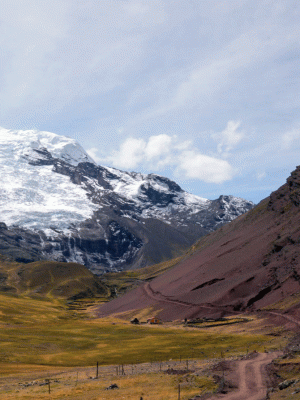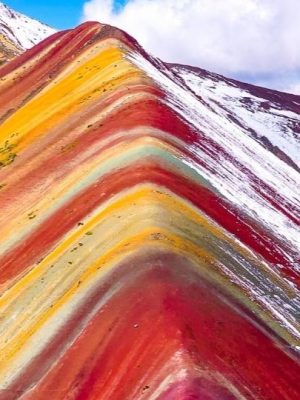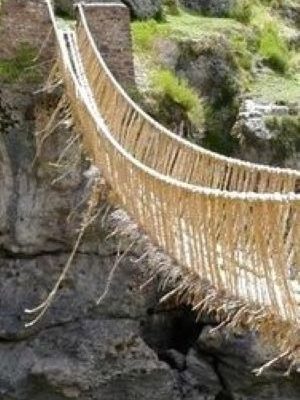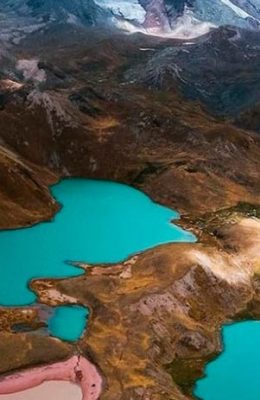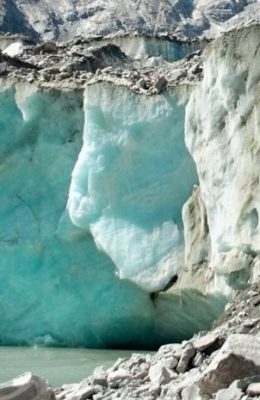CHOQUEQUIRAO
Choquequirao is an impressive Inca archaeological complex located in the Cusco region of Peru. It is often called the “sacred sister of Machu Picchu” due to its architectural similarities, beauty, and imposing mountaintop location, although it is much larger and less visited. Its name, which in Quechua means “Cradle of Gold,” alludes to the glow its rocks emit when illuminated by the sun.
Introduction
CHOQUERIAO
Choquequirao, often called the “sacred sister of Machu Picchu,” is a fascinating Inca archaeological complex. Unlike its famous counterpart, this site remains a hidden gem high in the Vilcabamba mountain range, accessible only on foot and offering an unparalleled trekking adventure.
Difficulty and Preparation
- Difficulty: Moderate to high due to altitude and uneven terrain
- Preparation: It is essential to acclimatize to the altitude before starting the trek.
- Equipment: Thermal clothing, trekking boots, hiking poles, sunscreen and camping gear
8 DAYS-NIGHTS 7
Day 1: Cusco – Cachora – Chiquisca
Morning: Early morning pick-up from your hotel in Cusco. You will be transported by bus to the town of Cachora (2,900m / 9,515 ft), the starting point of the trek.
Afternoon: Begin your hike, descending into the Apurímac River Canyon. The trail offers spectacular views of the Padreyoc snow-capped peak and the deep canyon. You will reach Chiquisca (1,930m / 6,332 ft) for the first night’s camp.
Hiking time: Approximately 6-7 hours.
Day 2: Chiquisca – Marampata – Choquequirao
Morning: An early start for the most challenging day of the trek. You will descend further to cross the Apurímac River at Playa Rosalina (1,550m / 5,085 ft) and then begin a long and steep ascent to Marampata (2,850m / 9,350 ft), a small village with breathtaking views of the Choquequirao complex.
Afternoon: After lunch, you will continue with a shorter hike to the Choquequirao Archaeological Complex (3,050m / 10,007 ft). Settle into your camp and enjoy the sunset.
Hiking time: Approximately 6-7 hours.
Day 3: Exploring Choquequirao – Pinchaunuyoc – Maizal
Morning: Wake up early to witness the magnificent sunrise over the ruins. You will have a guided tour of the main archaeological complex, including the main plaza, temples, and the famous llama terraces (Andenes de las Llamas).
Afternoon: Continue the trek, crossing the Choquequirao Pass (3,300m / 10,826 ft) and descending to the Río Blanco (1,900m / 6,233 ft). After crossing the river, you will begin a steep ascent to the campsite at Maizal (3,000m / 9,842 ft).
Hiking time: Approximately 7-8 hours.
Day 4: Maizal – Yanama
Morning: A challenging day of ascent. You will climb towards the Yanama Pass (4,660m / 15,288 ft), the highest point of the trek. Along the way, you’ll see ancient Inca mines (Minas Victoria) and enjoy panoramic views of the surrounding snow-capped peaks.
Afternoon: From the pass, you will descend to the remote village of Yanama (3,600m / 11,811 ft), where you will camp for the night.
Hiking time: Approximately 6-7 hours.
Day 5: Yanama – Totora – La Playa
Morning: The trail becomes less demanding as you descend through a lush valley. You will pass through the villages of Totora and Collpapampa, enjoying a change in scenery from the high mountains to a warmer, more humid climate.
Afternoon: Continue the descent to the jungle area. The trail follows the Santa Teresa River, leading to the campsite at La Playa (2,060m / 6,758 ft). Here you can rest and enjoy the warmer weather.
Hiking time: Approximately 7-8 hours.
Day 6: La Playa – Llactapata – Aguas Calientes
Morning: Trek through coffee and fruit plantations, then ascend to the Llactapata Archaeological Site. From this unique location, you will get your first incredible glimpse of Machu Picchu from a different perspective.
Afternoon: Descend to the Hidroeléctrica train station. From here, you will walk along the train tracks for a scenic hike to Aguas Calientes (2,040m / 6,692 ft), the town at the base of Machu Picchu. You can check into a hotel and enjoy a hot shower and a good meal.
Hiking time: Approximately 6-7 hours.
Day 7: Machu Picchu – Ollantaytambo – Cusco
Morning: Early morning bus ride to the citadel of Machu Picchu. You will have a comprehensive guided tour of the famous Inca city, visiting key sites like the Temple of the Sun, the Sacred Plaza, and the Intihuatana. You will also have free time to explore on your own.
Afternoon: Descend to Aguas Calientes for lunch. You will then take the train to Ollantaytambo and from there, a bus back to Cusco.
Hiking time: 2-hour guided tour, plus free time. Train and bus ride back to Cusco.
Day 8: Departure from Cusco
Morning: Enjoy a final breakfast in Cusco. Depending on your flight schedule, you can do some last-minute souvenir shopping or explore the city.
Afternoon: Transfer to the airport for your departure.
INCLUDES + ROUTE DETAILS
Transportation
Pickup from your hotel in Cusco.
Transportation to the trek start.
Meals
Breakfast, lunch, and dinner during the trek.
Snacks (tea, hot water, cookies).
Cook and assistants during the trek.
Safety
First aid kit.
Emergency oxygen.
Not included:
Admission (15-20 soles)
Tips
Before the Hike
Acclimatize: Arrive in Cusco at least 2–3 days early to acclimatize to the altitude.
Pre-training: Hiking, running, or light cardio to build endurance.
Sleep well: Avoid staying up late or drinking alcohol the day before.
Equipment and Clothing
Small backpack (30–40 L): To carry water, snacks, a camera, a coat, and daily essentials.
Large backpack (60–70 L): If you don’t hire additional porters (mules usually carry some of the weight).
Layered clothing:
Quick-drying t-shirts.
Fleece jackets or a mid-layered coat.
Waterproof and windproof jacket.
Thermal clothing for the evenings (it gets very cold in Soraypampa).
Trekking footwear: Sturdy, comfortable, and waterproof boots.
Sandals/light sneakers: For resting at camp.
Hat, sunscreen, and sunglasses (strong sun at high altitudes).
Gloves, hat, and scarf (it can get cold in the early morning).
Headlamp with extra batteries.
Sleeping bag with a temperature of -10°C (if not, rent one).
Food and Hydration
Bring a reusable bottle or camelback (minimum 1.5–2 L).
Water purification tablets or a personal filter.
Energy snacks: nuts, chocolate, cereal bars.
Avoid alcohol and heavy meals during the trip.
Health and Safety Tips
Walk at your own pace, without rushing (especially on the climb to Salkantay Pass, 4,650 m).
Use coca leaves or sorojchi pills if you experience symptoms of altitude sickness.
Protect yourself from the cold at night and from the sun during the day (sudden changes in weather).
Bring a personal first-aid kit: pain relievers, band-aids, and your own medications.
Always follow the guide’s instructions.
Extras to Consider
Cash in soles (for swims, extra snacks, tips, and the Cocalmayo hot springs).
Swimsuit and a light towel if you plan to go to the hot springs.
Camera with extra battery (there’s not always electricity to charge).

